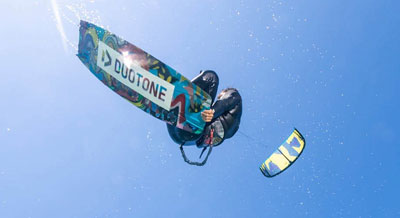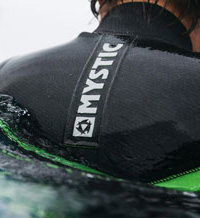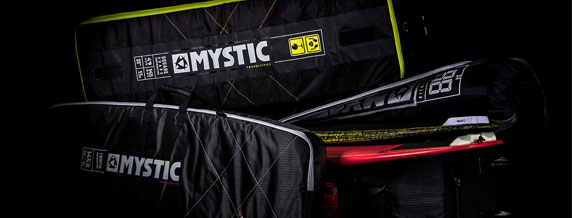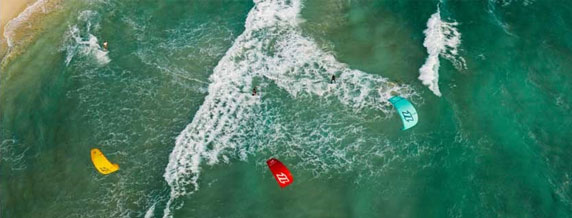Guide Kitesurf Débutant
Tout ce qu'il faut savoir sur les ailes, planches, combinaisons et harnais et comment sélectionner votre premier équipment! Découvrez toutes les informations essentielles pour débuter dans le kitesurf, accompagnées d'exemples de produits et kits complets. Besoin d'aide pour trouver le bon matériel de kitesurf? N'hesitez pas à nous contacter!
Sur quel sujet souhaitez-vous en apprendre plus ?

Acheter une Aile de kite
Nous vous aidons en tant que débutant à faire le bon choix d'aile.
Ailes pour Débutants
Vous venez tout juste de finir vos premières leçons de kitesurf et vous êtes complètement enthousiaste ! Vous voulez commencer immédiatement et acheter vos propres ailes de kitesurf pour progresser en toute autonomie sur vos talents de kiteur. Mais quel kite acheter ? Il y a tellement d'offres. Nous comprenons qu'il peut être difficile de faire un choix. Pour vous aider, nous avons répondons ici aux questions les plus fréquentes des débutants :
- Quels sont les 4 éléments indispensables que tout kite pour débutant doit avoir ?
- Quel kite acheter en tant que débutant ?
- Pourquoi les écoles de kitesurf utilisent souvent des ailes "vagues" ?
- Quelle taille d’aile devrais-je choisir en tant que débutant ?
- Quelle taille de barre de kitesurf me faut-il ?
- Ai-je besoin d'un leash long ou court ?
- En tant que débutant, devrais-je acheter une aile neuve ou d'occasion ?
- Existe-t-il une norme de sécurité pour les ailes de kitesurf ?
- Comment entretenir mon aile de kitesurf ?
Quels sont les 4 éléments indispensables que tout kite pour débutant doit avoir ?
Au début, vous souhaitez progresser le plus rapidement possible. Les 4 essentiels d'une aile de kitesurf pour débutant sont :
- Une aile avec de bonnes capacités au près, afin de remonter facilement face au vent.
- Une aile avec une grande plage de depower, pour ajuster facilement la puissance de votre aile.
- Un redécollage facile et rapide, pour relancer votre aile sans effort si elle tombe au sol ou dans l'eau.
- Une aile indulgente, qui permet de corriger facilement les erreurs et de gagner en contrôle et en confiance.
Quel kite acheter en tant que débutant ?
Si vous êtes complètement motivé après vos premières leçons et que vous prévoyez d'investir immédiatement dans une nouvelle aile, nous vous recommandons une aile polyvalente/freeride (en forme delta ou en forme C ouverte) idéale pour les débutants.
Chaque marque propose ce type d’aile dans sa gamme. Parmi les exemples, on trouve la Duotone Evo, la Cabrinha Moto, la North Reach, la F-one Bandit et la Naish Triad. Ce sont des ailes polyvalentes que vous pourrez utiliser sur le long terme. Elles conviennent parfaitement pour accompagner votre progression, relever de nouveaux défis et vous entraîner à réaliser vos premiers sauts.
Les marques ont créé des packs spéciaux pour débutants en utilisant ces ailes comme base. Découvrez ces packs de débutants abordables des différentes marques dès maintenant.

Pourquoi les écoles de kitesurf utilisent souvent des ailes "Vagues" ?
En tant que débutant en kitesurf, vous avez plusieurs types d’ailes parmi lesquelles choisir. Les plus faciles pour commencer sont généralement les ailes de type vagues. Ces ailes se distinguent par leur excellent depower, leur redécollage rapide et leur indulgence qui pardonne facilement les erreurs. Parmi les exemples, on retrouve la Cabrinha Drifter, la North Carve, l'Airush Session et la Duotone Neo.
Ces ailes sont souvent utilisées par les écoles de kitesurf pour enseigner. Leur grande capacité de depower permet de garder facilement le contrôle, même lorsque le vent se renforce. Leur redécollage rapide est un atout majeur, surtout lorsqu’on débute et qu’il arrive parfois de faire tomber l’aile dans l’eau. Vous pouvez ainsi la remettre en l'air rapidement. Enfin, il est toujours agréable d’avoir une aile dotée de bonnes performances au près, ce qui vous permet de revenir facilement à votre point de départ sans avoir à affronter le redouté « walk of shame » sur la plage.
Si vous pouvez acheter ou emprunter une aile wave d'occasion en bon état, ce serait un excellent choix pour un débutant en kitesurf. Vous pourrez vous entraîner à réaliser vos premiers waterstarts et maîtriser la remontée au vent.

Quelle taille d’aile devrais-je choisir en tant que débutant ?
La taille de l’aile que vous devriez choisir en tant que débutant dépend de plusieurs facteurs :
- Votre poids,
- Votre ensemble d'ailes prévu : 1, 2, 3 ou même plus ?
- Les conditions du spot où vous kitez (vitesse moyenne du vent, rafales, etc.).
Il est toujours recommandé de commencer avec la plus grande aile de votre ensemble prévu. Cela vous permettra de vous entraîner dans les conditions les plus faciles. Avec une grande aile, vous aurez besoin d'un vent d'environ force 5 (17 à 21 nœuds) pour naviguer. Dans ces conditions, l'eau est calme, le vent est stable et le temps est généralement agréable. Pour la plupart des kitesurfeurs, cela correspond à une aile de 9 à 12 mètres carrés, en fonction de votre poids. Nous vous conseillons de consulter votre instructeur de kitesurf ou de nous demander un dernier avis pour être sûr de votre choix.
Une fois que vous aurez maîtrisé les bases avec votre première aile, vous voudrez naturellement envisager votre deuxième. Parce que vous êtes déjà accro et que vous ne voulez pas manquer une session, tout en souhaitant naviguer dans des conditions de vent plus fortes. Vous serez peut-être aussi prêt à vous entraîner pour vos premiers sauts.
Lorsque vous envisagez un ensemble de deux ailes, il est judicieux d'avoir 3 mètres carrés de différence entre les deux pour couvrir la plus large plage de vent possible. Par exemple, une 12 m² et une 9 m², ou une 10 m² et une 7 m².
Si vous souhaitez vous équiper immédiatement avec trois ailes, le meilleur choix est d’avoir 2 mètres carrés de différence entre chaque aile : 12-10-8 ou 11-9-7 m². Partez toujours de votre plus grande aile et réduisez progressivement la taille.
| Poids | Taille d'aile |
|---|---|
| 30 - 40 kg | 5 - 6 m2 |
| 40 - 50 kg | 6 - 7 m2 |
| 50 - 60 kg | 7 - 8 m2 |
| 60 - 70 kg | 8 - 9 m2 |
| 70 - 80 kg | 9 - 11 m2 |
| 80 - 90 kg | 10 - 12 m2 |
| 90 - 100 kg | 11 - 13 m2 |
| 100 - 110 kg | 12 - 14 m2 |
Quelle taille de barre de kitesurf me faut-il
La taille de la barre est moins importante que celle de l’aile. En réalité, n’importe quelle barre d’une marque spécifique peut être utilisée avec une aile associée de la même marque. Lorsqu’une marque de kitesurf propose différentes tailles de barres, on peut généralement supposer que la barre plus petite est destinée aux ailes de moins de 10 m², tandis que la barre plus grande est recommandée pour les ailes de 10 m² et plus. La barre plus grande permet de créer un angle de pilotage plus important, ce qui accélère la maniabilité des grandes ailes et les rend moins lentes à diriger.
Si vous envisagez d’utiliser une barre d’une autre marque sur une aile différente, vous devez faire attention à plusieurs éléments. Par exemple, il est essentiel de savoir si la barre possède une séparation haute ou basse des lignes de puissance, et de vérifier si l’aile est conçue pour ce type de configuration. Si les deux ne correspondent pas, n’utilisez pas cette barre avec cette aile, car cela pourrait altérer complètement les caractéristiques de vol de l’aile. Il est également important de vérifier si les extrémités de la barre et de l’aile sont compatibles pour l’attache : les boucles et noeuds doivent correspondre. Si ce n’est pas le cas, cela peut être corrigé avec un kit de rallonges de type "pigtails". Une barre de kitesurf compatible avec presque toutes les ailes est la Duotone Click Bar.Si vous avez des questions concernant votre barre et sa compatibilité avec votre aile, n’hésitez pas à nous contacter.

Ai-je besoin d'un leash long ou court ?
Lorsque vous débutez en kitesurf, il est préférable d’utiliser un leash court. Celui-ci se fixe à l’avant de votre harnais. Ainsi, lorsque vous en avez besoin, il reste toujours à portée de main. Une fois que vous avez déclenché la sécurité et que l’aile est uniquement attachée à votre leash, vous serez tiré face à l’aile.Ceci est différent d’un leash long, qui se fixe à l’arrière du harnais. Ce type de leash est utilisé uniquement par les kitesurfeurs avancés pour réaliser des figures déhookées comme les handle passes. En tant que débutant, optez pour un leash court : il est plus pratique et plus adapté à votre niveau.
En tant que débutant, devrais-je acheter une aile neuve ou d'occasion ?
La sécurité est l’aspect le plus important dans notre sport. Le kitesurf est et reste un sport extrême, c’est pourquoi il est crucial que votre aile soit en bon état. Une aile neuve répond aux dernières normes de sécurité, et ses lignes sont en parfait état, ce qui en fait toujours l’option la plus sûre. De plus, le tissu d’une aile neuve est complètement intact, ce qui lui permet de gérer le vent de manière optimale. Vous bénéficierez ainsi d’un pilotage plus précis et d’une meilleure performance dans le bas de la plage de vent. Cela rend le kitesurf plus facile pour vous en tant que débutant et vous permettra de progresser plus rapidement. Il est donc conseillé de commencer avec du matériel de kitesurf neuf. En achetant un pack complet (aile, barre, planche et fixations), la différence de prix avec du matériel d’occasion en bon état est souvent minime.Découvrez nos packs de kitesurf ici
Bien sûr, vous pouvez également acheter une aile d'occasion, mais il y a plusieurs points à prendre en compte. Il est préférable d’éviter d’acheter une aile de plus de six ans. Le kitesurf est un sport jeune, et chaque année, de nouvelles technologies sont intégrées aux ailes récentes, les rendant plus efficaces et plus sûres. Il y a cinq ans à peine, le kitesurf était presque un sport différent. L’industrie a fait de grands progrès en matière de systèmes de sécurité et de matériaux utilisés. Gardez donc cela à l’esprit lors de votre choix.
Il est également très important de vérifier une aile d'occasion pour détecter d'éventuelles réparations ou dommages. Une réparation unique, si elle a été effectuée par un réparateur professionnel, ne devrait pas poser de problème. En revanche, une aile fortement réparée peut devenir déséquilibrée, ce qui la rend instable et dangereuse. Si vous recherchez une aile d'occasion sur internet, vous verrez de nombreuses offres à bas prix. Faites attention aux ailes trop bon marché. Le bon marché revient souvent cher. Ces ailes sont souvent moins adaptées aux débutants et peuvent être dangereuses en raison de systèmes de sécurité très anciens, d’un redécollage difficile et de technologies dépassées.
N’achetez jamais une aile de type C en tant que débutant. Les ailes en C sont presque exclusivement utilisées par les kitesurfeurs professionnels, car elles offrent une puissance et une précision exceptionnelles. Cependant, leur principal inconvénient est qu’une erreur peut être commise rapidement, ce qui peut entraîner une situation dangereuse.
Si vous êtes débutant et que vous avez besoin d’un tout nouveau pack de kitesurf comprenant une aile, une barre, une planche et des fixations, nous avons conçu plusieurs packs spécifiques à chaque marque de kite avec une très belle réduction. Un pack remisé peut parfois presque équivaloir au prix d’un ensemble de kitesurf d’occasion de bonne qualité.
Si votre budget ne vous permet pas d’acheter un pack neuf, vous pouvez toujours nous contacter pour voir si nous avons une aile d’occasion de bonne qualité disponible pour vous.
Existe-t-il une norme de sécurité pour les ailes de kitesurf ?
Il n’existe pas encore de norme de sécurité spécifique pour les ailes de kitesurf. Cependant, il existe une norme de sécurité pour le système de largage rapide sur la barre : le système de quick release. Depuis 2021, les derniers systèmes de largage rapide sont conformes à la norme ISO 21853. Si votre système de quick release respecte cette norme ISO, vous pouvez être assuré qu’il fonctionnera même dans les conditions les plus extrêmes. Vous pourrez ainsi profiter de ce magnifique sport en toute sérénité.
Comment entretenir mon aile de kitesurf ?
Votre aile de kitesurf ne nécessite pas beaucoup d’entretien. L’essentiel est de ne pas la ranger lorsqu’elle est encore humide. Il peut bien sûr arriver que vous deviez la plier mouillée à cause de la pluie. Dans ce cas, assurez-vous de la faire sécher dès que possible. Si vous ne le faites pas, il y a un risque que de la moisissure se développe sur le tissu de votre aile.
Découvrez toutes les ailes disponibles pour les débutants. >>
Maintenant que vous savez tout sur le choix de votre première aile, vous êtes prêt à faire votre sélection !
Si vous avez des questions, n’hésitez pas à nous appeler, nous envoyer un email, un message WhatsApp ou à visiter notre magasin à Noordwijk !
Ajouté au panier
| Sous-total | € 0,00 |
| Frais de livraison NL | € 0,00 |
| Total (incl 0% TVA) | € 0,00 |
Vous n'avez pas de produit(s) dans votre panier
Vous ne savez pas par où commencer?
Visitez notre service client pour obtenir des conseils
Gestion du consentement aux cookies
Nous souhaitons vous offrir la meilleure expérience possible et les offres les plus pertinentes sur notre site web, dans nos médias et à travers nos annonces. Pour ce faire, nous devons utiliser des cookies et collecter certaines données. Si vous êtes d'accord, appuyez sur le bouton vert ! Pour en savoir plus, cliquez ici ou modifiez les paramètres selon vos préférences.
Cookies fonctionnels
Toujours actif
Cookies analytiques
Cookies publicitaires
Partage des données utilisateur
Cookies de personnalisation









